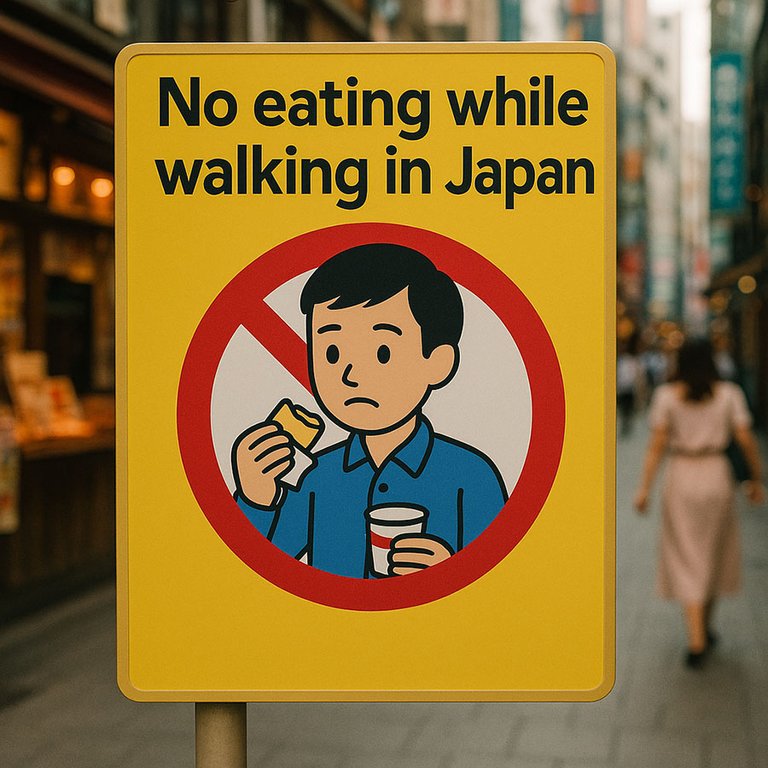Why You Don’t See People Eating While Walking in Japan
A week or so ago, I wrote a post about how sitting on the ground in public spaces in Japan can carry different connotations than it does in the West. Read it here. I received a comment from @koto-art who mentioned another everyday difference: snacking while walking.

And she’s absolutely right. This is another one of those quietly ingrained cultural habits that often surprises first-time visitors to Japan — not because it’s strange, but because of how normal it is everywhere else. If you are the type to pay attention, you sort of notice after awhile: Huh. No one else is eating while walking. Am I doing something wrong?[1]
As I’m sure you’ve seen on YouTube or read about, Japan has convenience stores on almost every corner, even in the smallest town. These truly are convenient and sell a wide variety of useful things, not like the modern US convenience stores that typically only have junk food, random items for your car, and questionable hotdogs. You might be tempted to stop in one of theses places, buy a snack and eat it while walking.
Don’t!
Let’s compare this to the U.S., where walking down the street with a slice of pizza, a coffee, or even a burrito is perfectly normal. In New York or Chicago, someone eating on the subway or while crossing a busy street is an everyday sight. In Japan, it’s not forbidden, exactly — but it is considered a little sloppy. Or worse, inconsiderate and rude.
Why does this difference exist?
- Cleanliness: Japan places a high value on keeping public spaces clean. Eating while walking risks spilling food, dropping wrappers, dripping sauce, or just getting crumbs everywhere. Even if you don’t make a mess, the idea that you might is enough to make the entire act feel rude.
- Mindfulness: There’s an unspoken cultural expectation in Japan that eating should be done intentionally. Now, this is a little idealistic. People aren’t monks maintaining silence and complete focus while eating. But that said, this all does work into the cultural expectation. You sit, you eat, you focus on the food. Even if it’s something small, like an onigiri from 7-Eleven, the norm is to step off to the side, finish it, and move on.[2]
- Space-sharing etiquette: Japanese streets and sidewalks can be narrow, and public transport is famously packed. Eating in close quarters with strangers who might not want to smell your food — or hear you chewing[3] — is considered poor manners.
- Historical roots: The idea that walking while eating is childish or impolite goes back centuries. Even in samurai times, there were notions of proper comportment in public, and those ideas trickled down into modern social norms.
Exceptions and changes
Like most cultural norms, this one is softening — especially among the younger generation. In big cities like Tokyo and Osaka, you do sometimes see people eating on the go. Convenience store culture makes it easier than ever to do so, and the sheer pace of life means people sometimes trade etiquette for efficiency.
And of course, festivals are a huge exception. At any given matsuri, you’ll see kids and adults alike walking around with chocolate bananas, fried squid, and dripping kakigōri. But again, these are special contexts — temporarily carved out from the usual rules.
It’s also not that rare to see a tired salaryman heading home on the train sneaking a bite of something out of his bag — or a drink of a beer — when he thinks no one is looking. He knows it’s frowned upon, but he’s tired from work and thinks he can get away with it. As long as he is trying to be discreet, most people look the other way.
Speaking of that beer, what about drinks?
Drinking while walking is more accepted. You’ll often see people sipping bottled tea or canned coffee, especially during commutes. But even then, there’s usually a subtle effort to finish it quickly or discreetly. You won’t often see someone sipping a venti Frappuccino while leisurely strolling through a train station.
As a visitor — what should you do?
If you’re traveling in Japan and you’re not sure what’s appropriate, just watch the people around you. If you don’t see others doing it, that’s your clue. And if you really need that onigiri on the go? As I was told long ago, back when I was still a fresh face in the country: step out of the way, squat down, and eat it as quickly as you can.
No one will yell at you for munching while walking, but you’ll be silently marked as an outsider. Whether that matters to you is up to you, but as a foreigner living here, I’d urge you to be a little more aware.
-
You’re not, technically. Kind of. But you’re also not fitting in and are in fact unwittingly playing into the “foreigners have no manners” stereotype. ↩
-
In the past, it wouldn’t be strange to see Japanese people squatting down outside the store and eating that onigiri. When you just had to eat now squatting down out of the way was the way to do it. You see this less these days due in no small part to most modern convenience stores having little seating areas inside. ↩
-
The random ASMR chewing lover aside. ↩
❦
 |
David is an American teacher and translator lost in Japan, trying to capture the beauty of this country one photo at a time and searching for the perfect haiku. He blogs here and at laspina.org. Write him on Mastodon. |
I feel like this one is changing pretty quickly. It’s still not nearly as common as it is in other countries, but I wouldn’t be surprised if it were in five years.
I hope the younger generation in Japan doesn’t pick up on the mega-sized My Cup that everyone in America seems to have at their side at all times. That really drives me crazy when I visit the States.
Funny thing is when I have students go to the States and come back, those massive gas station drinks and the equally giant travel cups everyone seems to have are one of the things almost everyone mentions to me when they get back. They really make an impression.
They’re certainly hard to miss.
I can’t believe how people just carry them around like permanent accessories while they’re walking, working, driving, etc.
It seems like a symptom of massive insecurity to me, but maybe that’s going to far.
Thank you sir for the informative tips.
You're welcome!
Interesting and fun to read, thank you for sharing, as an European I like the Japanese culture, I'm not much of a traveler though 😅
Glad you enjoyed.
https://www.reddit.com/r/JapanTravelTips/comments/1lb2oti/why_you_dont_see_people_eating_while_walking_in/
https://www.reddit.com/r/NoStupidQuestions/comments/1lcbl2s/is_it_true_that_you_arent_allowed_to_eat_while/
This post has been shared on Reddit by @flummi97, @stekene through the HivePosh initiative.
hmmmmmm, the Japanese seem to have things more right compared to us westerners. what a nice country it is! 😉😎👊